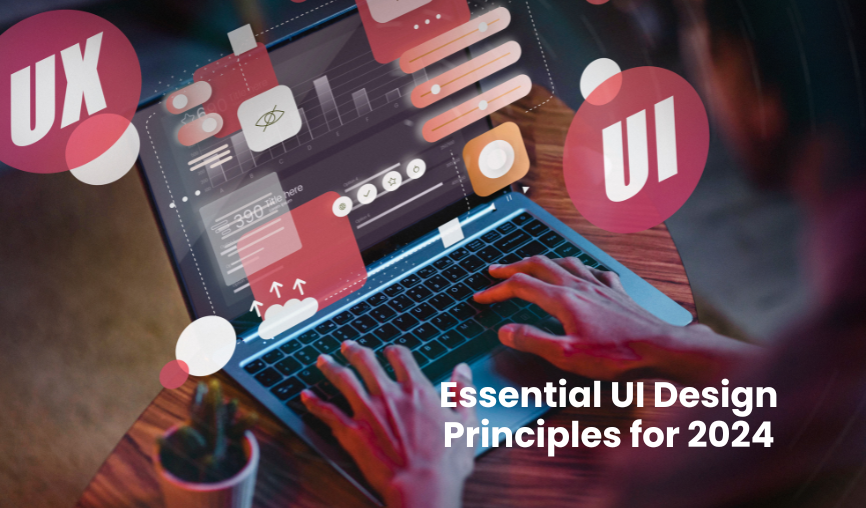
2024 UI Design Trends: 5 Key Principles for Effective Interfaces
In the ever-evolving landscape of digital interaction, user interface (UI) design serves as the bridge between humans and technology, shaping the way we interact with digital products and platforms. As we navigate the complexities of designing for an increasingly interconnected world, it’s essential to understand the fundamental principles and best practices that drive effective UI design in 2024. In this comprehensive guide, we’ll explore the essence of UI design, the different types it encompasses, its relationship with user experience (UX) design, and delve into five key principles essential for crafting compelling interfaces in the digital age.
What is UI Design?
User Interface (UI) design focuses on creating visually appealing and intuitive interfaces that facilitate seamless interaction between users and digital products or platforms. It encompasses the design of elements such as buttons, menus, navigation bars, and interactive components, with the goal of enhancing usability, accessibility, and overall user satisfaction.
Types of UI Design:
UI design encompasses a variety of types, each tailored to different contexts and platforms. Some common types of UI design include:
- Graphic User Interface (GUI): GUI design involves the creation of visual elements, such as icons, typography, and color schemes, that make up the graphical interface of a digital product or platform.
- Web UI Design: Web UI design focuses on creating interfaces for websites, ensuring optimal usability and accessibility across various web browsers and devices.
- Mobile UI Design: Mobile UI design is specific to designing interfaces for mobile applications, taking into account the unique constraints and interaction patterns of mobile devices.
- Voice UI Design: Voice UI design involves designing interfaces that allow users to interact with digital products or platforms using voice commands, such as virtual assistants and smart speakers.
UI Design vs. UX Design:
While UI design and user experience (UX) design are closely related, they serve distinct roles in the design process. UI design focuses on the visual and interactive aspects of an interface, while UX design encompasses the overall user experience, including factors such as usability, accessibility, and user satisfaction. In essence, UI design is about how an interface looks and feels, while UX design is about how it works and how users experience it.
ALSO READ : How UX Design Can Satisfy Users and Business Goals ?
5 Key UI Design Principles for an Effective User Interface in 2024:
In 2024, the following key UI design principles are essential for crafting effective user interfaces:
- Minimalism with Purpose: In an era characterized by information overload, simplicity reigns supreme. Minimalist UI design, with its clean layouts, ample white space, and concise elements, remains a cornerstone of modern interface design. However, in 2024, minimalism goes beyond mere aesthetics; it is about purposeful simplicity. Designers must prioritize essential content and functionality while eliminating clutter and distractions. By adopting a minimalist approach, UI designers can create interfaces that are not only visually appealing but also easy to navigate and comprehend.
- Adaptive and Responsive Design: With the proliferation of devices and screen sizes, designing for multiple platforms has become a necessity rather than a luxury. In 2024, UI designers must embrace adaptive and responsive design principles to ensure seamless experiences across various devices and screen resolutions. By leveraging fluid layouts, flexible grids, and media queries, designers can create interfaces that effortlessly adapt to the user’s device, whether it’s a smartphone, tablet, or desktop computer. Adaptive and responsive design not only enhances accessibility but also future-proofs the interface against technological advancements.
- Consistency Across Platforms: Consistency is key to establishing trust and familiarity with users. In 2024, UI designers must strive for consistency not only within a single platform but also across multiple platforms and touchpoints. Whether a user interacts with an interface on a mobile app, a website, or a smart device, they should encounter consistent design elements, branding, and interaction patterns. By maintaining coherence across platforms, designers can streamline the user’s journey and facilitate seamless transitions between different interfaces, enhancing usability and user satisfaction.
- Accessibility for All: Inclusivity is a fundamental principle of modern UI design. In 2024, designers must prioritize accessibility to ensure that interfaces are usable by individuals of all abilities, including those with disabilities. This involves adhering to accessibility standards such as the Web Content Accessibility Guidelines (WCAG), implementing features such as keyboard navigation, alternative text for images, and ensuring sufficient color contrast for readability. By designing with accessibility in mind, UI designers can create interfaces that are not only ethical but also more widely usable and impactful.
- Delightful Microinteractions: Microinteractions are the subtle animations, transitions, and feedback mechanisms that enhance the user experience by adding personality and charm to interfaces. In 2024, UI designers must leverage microinteractions strategically to delight users and create memorable experiences. Whether it’s a playful loading animation, a satisfying swipe gesture, or a subtle notification badge, well-executed microinteractions can elevate the overall perception of an interface and foster a deeper emotional connection with users.
In conclusion, UI design in 2024 is characterized by a blend of simplicity, adaptability, consistency, accessibility, and delight. By adhering to these key principles, designers can create interfaces that not only meet the evolving needs and expectations of users but also leave a lasting impression. As technology continues to advance and user preferences evolve, embracing these principles will be essential for crafting effective and impactful user interfaces in the years to come.
Leave A Comment
Search
Recent Post

Top 8 Technology Trends to Drive Growth in 2024
16 April. 2024

Reports on Autopilot: Can GA4 Really Be This Easy?
5 March. 2024

Web3 and the Metaverse: A New Era for the Internet?
27 February. 2024

How AI is Reshaping Search Engine Optimization?
22 February. 2024

Is GEMINI the Next Game-Changer for Your Business?
20 February. 2024

5 Digital Marketing Trends You Need to Know in 2024
16 February. 2024

Is Your Website Talking Back? Dominate Voice Search with These 3 Hacks!
13 February. 2024

Unexpected Ways Apple Vision Pro Will Change India: Beyond the Hype
8 February. 2024

How UX Design Can Satisfy Users and Business Goals ?






















